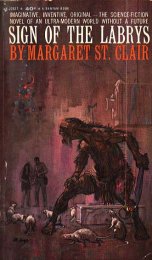
Sign of the Labrys
Margaret St. Clair
139 pages
published in 1963
The back cover blurb on this one has to be seen to be believed:
Women are writing science-fiction!
Original!Brilliant!!Dazzling!!!
Women are closer to the primitive than men. They are conscious of the moon-pulls, the earth-tides. They posses a buried memory of humankind's obscure and ancient past which can emerge to uniquely color and flavor a novel.Such a woman is Margaret St. Clair, author of this novel. Such a novel is this, SIGN OF THE LABRYS, the story of a doomed world of the future, saved by recourse to ageless, immemorial rites...
Fresh!Imaginative!!Inventive!!!
I mean, really. It wasn't even as if women sf writers where that uncommon when Sign of the Labrys was published: Leigh Brackett, C. L. Moore, Katherine MacLean, Zenna Henderson, Judith Merril and Andre Norton, to name just a few all wrote before 1963. Margaret St. Clair herself had debuted in 1946 and written quite a few short stories, as well as several novels before Sign of the Labrys. Still, the blurb did what it was supposed to do: got me to buy this novel and read it.
It is not even half as lurid as the blurb made it out to be. Sign of the Labrys is in fact a solid old-fashioned science fiction story. It's pretty well written, better than the standard of the time. Most pre-New Wave science fiction writing is somewhat bland: the writing is there only to further the plot or to show off as efficiently as possible the neat idea the writer has thought of. In contrast, St Clair's writing is almost lyrical in places, a pleasure to read. She has also spend enough time on characterisation to make her protagonist come to life.
Her protagonist, Sam Sewell lives in a post-apocalyptic world, a world where horrific yeast based diseases killed off most people. These diseases either escaped or were deliberately released from a military laboratory as an alternative to global nuclear war. Needless to say this has traumatised Sam, as it did with most survivors. People avoid each other, are emotionally stunted and shell shocked. This in contrast to far too many post apocalyptic stories, where the survivors are either having a whale of a time playing with all the neat goodies left behind after the disaster or are busy creating the perfect new world on the smoking ruins of the old...
The plot starts one day when Sam is contacted by an agent of the FBY, the Federal Bureau of Yeast, who wants to know about the woman he is supposed to live with, one Despoina, who is suspected of being a Sower, someone who deliberately releases deadly neurolyic strains of yeast, a "blind massmurderer". Sam is puzzled and upset by this request, as he can barely tolerate other people and certainly doesn't live together with anyone...
From this moment on Sam's world gets gradually stranger, as he is driven to go on a quest to find Despoina and so learn the truth of his world. To do so he literally has to go deep underground in search of buried secrets...
Despoina in the meanwhile is not quite what the FBY agent told Sam. Sam soon learns she is a Witch, though not the sort of witch Sam first thinks of, the stereotypical old hag who rides a broomstick. What she is, is what we now would call Wiccan, something that the title of the novel hints of already. A Labrys is a double headed ritual axe, as used in Minoan religious rites in ancient Greece and later adopted by neopagans. Sam Sewell, as you may guess has to be initiated into Witchhood and Despoina is the person who has to lead him to the Craft. Witches have of course superhuman powers and they need Sam to help better the world. Their opponents being the FBY, who are busy trying to establish a dictatorship.
The infusion of what at first seemed a fairly standard science fiction story with a dose of Wicca worked pretty well. If necessary, you can ignore all the Wicca mumbo-jumbo and just think of it as psionics. In short, quite an interesting little novel which doesn't deserve its main claim to fame being the ludicrous backcover blurb.
Review by Chas S. Clifton, who looked at it from a more Wiccan point of view.